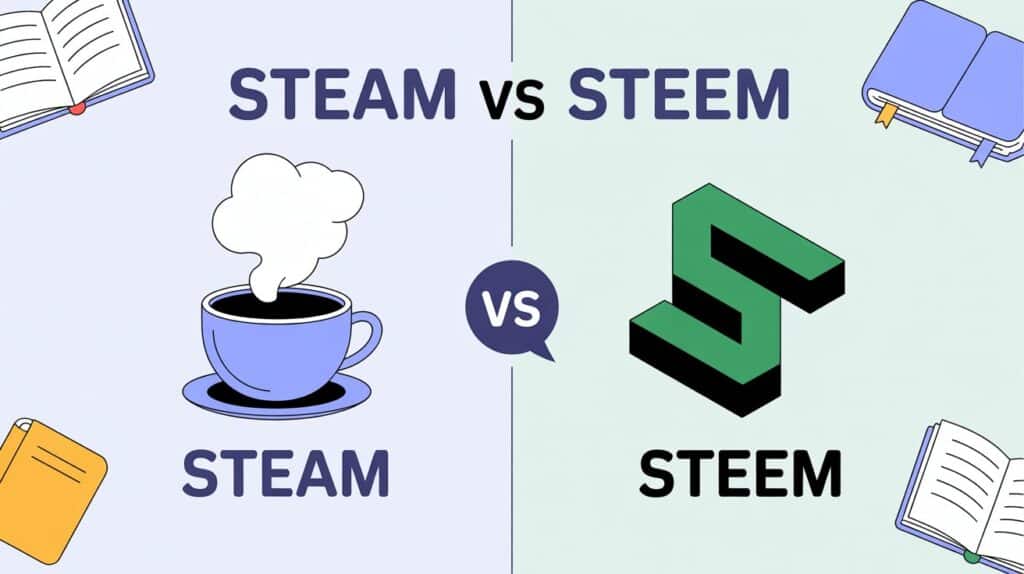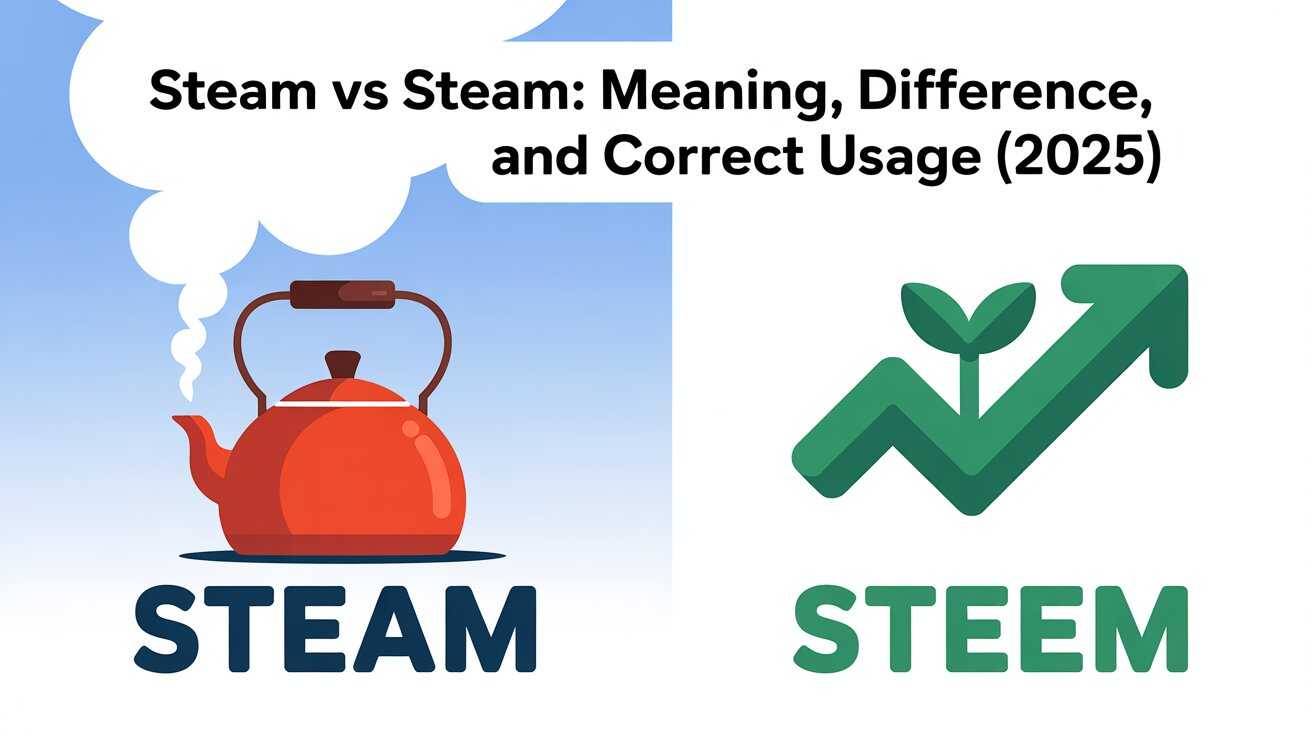Have you ever come across the words “steam” and “steem” and wondered if they mean the same thing or if one is just a misspelling of the other? You’re not alone! Many English learners and even native speakers get confused between these two similar-looking words. Steam vs Steem
we’ll break down steam vs steem in simple terms, explain their meanings, highlight the key differences, and show you how to use each correctly in sentences. Whether you’re writing professionally or just brushing up on your grammar skills, this guide will clear up all your doubts about steam vs steem (and steem vs steam) once and for all.
Why People Confuse Steam vs Steem
If you’ve ever paused while typing and wondered whether to use steam or steem, you’re not alone. Both words sound exactly the same, but they mean completely different things. Many English learners, gamers, and even native speakers mix them up—especially online.
we’ll clear up the confusion between steam vs steem, explore their meanings, look at their correct usage, and give you examples that make it simple to remember. Let’s break it down in the easiest way possible.
What Does “Steam” Mean?
The word steam is a real English word used both as a noun and a verb. It refers to the vapor that forms when water is heated, or the act of producing that vapor.
Definition of Steam
- As a noun: Steam is the hot mist created when water boils.
- As a verb: To steam means to give off vapor or cook something with steam.
Here’s a quick table for clarity:
| Word Form | Part of Speech | Meaning | Example Sentence |
|---|---|---|---|
| Steam | Noun | Vapor from boiling water | The steam rose from the tea kettle. |
| Steam | Verb | To emit vapor or cook with vapor | She steamed vegetables for lunch. |
In short: “Steam” is the correct and standard English spelling found in all major dictionaries such as Oxford and Merriam-Webster.
What Does “Steem” Mean?
Unlike steam, the word steem is not a recognized English word in grammar or dictionaries. However, it does exist as a brand name in the world of cryptocurrency and blockchain.
- Steem is the name of a blockchain-based social media platform that rewards users for posting and curating content.
- It’s also the name of the cryptocurrency used on that platform: Steem Coin.
So, while “steem” is technically correct in that specific context (as a proper noun referring to the blockchain), it’s not a real English word for everyday use.
If you’re writing essays, emails, or articles in standard English, you should always use steam, not steem.
Steam vs Steem — Key Differences

Here’s a simple comparison to help you remember the difference:
| Comparison Point | Steam | Steem |
|---|---|---|
| Part of Speech | Noun / Verb | Proper noun (Brand name) |
| Meaning | Water vapor or process of vaporizing | Blockchain-based social platform / cryptocurrency |
| Usage | Used in general English | Used only as a brand name |
| Correct Spelling in English | ✅ Correct | ❌ Incorrect (unless referring to brand) |
| Example | The steam fogged the windows. | He earns tokens on the Steem platform. |
In short, steam belongs to the dictionary, while Steem belongs to the tech world.
Steam vs Steem Pronunciation
Interestingly, both steam and steem are pronounced the same way: /stiːm/ (sounds like “steem”).
That’s exactly why so many people get them confused. The sound is identical, but their meanings and spellings are not.
So, when speaking, context helps; but when writing, spelling accuracy matters.
READ MORE >>> “Proove or Prove: Which Spelling Is Correct?”
Why “Steam” Is the Correct Word in English
If your intention is to talk about heat, vapor, or even the gaming platform “Steam” (by Valve), the correct spelling is always steam.
Here’s why:
- “Steam” appears in every English dictionary.
- It’s accepted in academic writing, casual conversations, and professional documents.
- “Steem,” however, appears only as a brand or proper noun.
So if you’re writing about boiling water, energy, or even “Steam games,” use steam, not steem.
Conversational example:
“If you’re cooking rice or talking about your favorite game on Steam, don’t add that extra ‘e’—it doesn’t belong there!”
Examples of Steam in Sentences
Let’s look at a few examples that show how to use steam correctly:
- The steam from the coffee fogged up my glasses.
- She steamed the vegetables for a healthy dinner.
- The train moved ahead with steam powering its engine.
- The bathroom mirror was covered with steam after a hot shower.
- He was so angry that you could almost see steam coming from his ears.
Incorrect:
I love watching the steem rise from my tea. ❌
Correct:
I love watching the steam rise from my tea. ✅
Steam vs Steem in Technology & Gaming Context
In technology and gaming, both words appear—but only one is correct in standard English writing.
- Steam (by Valve): A popular gaming platform for downloading, playing, and managing PC games. Example: I just bought a new game on Steam.
- Steem: A decentralized social media and blockchain platform launched in 2016. Users post content and earn Steem cryptocurrency.
Key takeaway:
The “Steam” platform relates to gaming, while the “Steem” platform relates to blockchain.
If you’re referring to the gaming service, always write Steam with the correct spelling.
Grammar Tip — Always Choose Steam for English Writing
Here’s an easy way to remember:
“Steam” is part of English. “Steem” is part of crypto.
So, unless you’re talking about cryptocurrency, steam is always the right word.
Even in brand names or creative writing, sticking with standard English helps your content remain clear, credible, and professional.
You can also add proofreading extensions or enable your spellchecker in WordPress or Google Docs to automatically catch this confusion.
Related Confusing Word Pairs
English has plenty of other confusing pairs just like steam vs steem. If you often mix up spellings, you might also find these articles helpful:
- Rain vs Reign — Weather or Royal Power?
- Lose vs Loose — One letter can change meaning completely.
- Brake vs Break — Stop your car or snap something apart?
👉 Check out our other word comparison guides on synataxveins.com to sharpen your grammar skills.
Quick Summary Table — Steam vs Steem
| Feature | Steam | Steem |
|---|---|---|
| Correct English Word | ✅ Yes | ❌ No |
| Dictionary Presence | Yes | No (brand only) |
| Common Use | Grammar, science, gaming | Cryptocurrency |
| Pronunciation | /stiːm/ | /stiːm/ |
| Example Sentence | The kettle produced steam. | He posted on Steem. |
Frequently Asked Questions (FAQs)
1. Is it Steem or Steam?
The correct spelling in most contexts is “steam.” It refers to the vapor that forms when water is heated — like what you see rising from a boiling kettle.
On the other hand, “steem” is not a standard English word. However, “Steem” (with a capital “S”) is a proper noun — the name of a blockchain-based social media platform where users earn cryptocurrency for their content. So, if you’re talking about water vapor, use steam. If you’re referring to the digital platform, use Steem.
2. What is a Steem?
Steem is a cryptocurrency and blockchain-based social media platform that rewards users for creating and curating content. It was launched in 2016 as part of the Steemit ecosystem. Users earn Steem tokens that can be traded or converted into other cryptocurrencies.
👉 Example: She earned Steem tokens by posting on the Steemit platform.
3. What is the difference between STEM and STEAM?
While these two acronyms sound alike, they represent different educational concepts:
- STEM stands for Science, Technology, Engineering, and Mathematics.
- STEAM adds an “A” for Arts, emphasizing creativity and design alongside technical skills.
👉 In short:
| Term | Full Form | Focus |
|---|---|---|
| STEM | Science, Technology, Engineering, Mathematics | Technical and analytical skills |
| STEAM | Science, Technology, Engineering, Arts, Mathematics | Blends creativity with science and technology |
So, STEAM education is the modern, more inclusive approach to learning.
4. Is it STEAM or Steamed?
Both words are correct, but they’re used differently depending on grammar:
- Steam (noun/verb): Refers to vapor or the process of heating with vapor.
👉 Example: The pot is full of steam. - Steamed (verb – past tense): Means something was heated using steam.
👉 Example: She steamed the vegetables for dinner.
In short, steam is the base form, and steamed is its past form.
Common Mistakes Between Steam and Steem
People often confuse steam and steem because:
- They sound exactly the same.
- Fast typing leads to extra or missing letters.
- The Steem cryptocurrency made the incorrect spelling more visible online.
Tip: Always double-check your writing with tools like Grammarly or ProWritingAid—they’ll immediately flag “steem” as a spelling mistake unless it’s a proper name.
Conclusion — The Final Verdict on Steam vs Steem
Now that you know the difference, choosing between steam and steem should be easy.
- Steam is a legitimate English word that refers to vapor, energy, or even the gaming platform.
- Steem is only correct when referring to the blockchain or cryptocurrency project.
So, the next time you’re writing an email, blog post, or social media caption, remember:
If it’s about water, cooking, or gaming — it’s steam. If it’s about crypto — it’s Steem.
Understanding the small differences between words like steam vs steem can make your writing clearer and more professional. Keep practicing, stay curious, and keep improving your English vocabulary with Synatax Veins.

